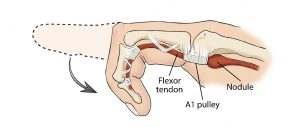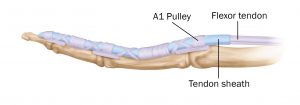The flexor tendons of the hand course through fibrous sheaths called pulleys that are located on the palmar surface of the fingers. These pulleys serve to maintain the flexor tendons appropriately against the fingers to prevent bowstringing during flexion. A trigger finger occurs when the flexor tendon is inhibited from gliding smoothly through the A1 pulley located at the base of the fingers and thumb. This can cause pain and catching of the finger in motion. In more severe cases, the finger can become locked in position due to the inability of the tendon to pass through the pulley. The picture below on the left depicts normal anatomy. The picture on the right depicts a thickened nodule getting caught in the A1 pulley.


Treatment options include rest, splinting and NSAIDs with a wide range of variability in successful outcomes (40-97%). Injections are also consider with anywhere from 60-90% resolution of symptoms. If conservative therapy fails, then a trigger release is recommended.
Surgical treatment of a trigger finger requires a small incision and surgical release of the A1 pulley. This is done as an outpatient procedure and a small soft dressing is applied. Minimal pain medications are usually required. The goal of rehabilitation after trigger finger release is to allow for wound healing while still maintaining the function of the fingers. Heavy gripping is prohibited for 6 weeks to allow wound healing.